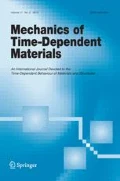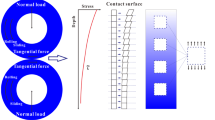Abstract
Pearlitic steels are well known for their high strength and hardness. This makes them the natural choice for applications in which structural integrity and minimum irreversible deformation over time are required. Although their room-temperature mechanical response has been intensively studied in the past, little information can be found in the literature regarding the effect of temperature on the mechanical response of pearlitic steels. In this paper, an experimental–numerical approach is used to study the mechanical response of pearlitic steels in the temperature range 20–500 °C. A finite-strain thermo-viscoplastic model is presented together with a set of elevated temperature tests (tensile and creep tests). The aim of the tests is twofold: first, to provide insight into the elevated-temperature mechanical response of the material; and second, to provide the data required to identify the corresponding material parameters. Furthermore, the model and the experimental data are instrumental in showing that the influence of temperature on the mechanical behavior of pearlitic steels becomes significant for temperatures above 350–400 °C.





Similar content being viewed by others
References
Allain, S., Bouaziz, O.: Microstructure based modeling for the mechanical behavior of ferrite–pearlite steels suitable to capture isotropic and kinematic hardening. Mater. Sci. Eng. A, Struct. Mater.: Prop. Microstruct. Process. 496(1), 329–336 (2008)
Atienza, J., Elices, M.: Behavior of prestressing steels after a simulated fire: fire-induced damages. Constr. Build. Mater. 23(8), 2932–2940 (2009)
Chaboche, J.: A review of some plasticity and viscoplasticity constitutive theories. Int. J. Plast. 24, 1642–1693 (2008)
Chuzhoy, L., DeVor, R., Kapoor, S., Bamman, D.: Microstructure-level modelling of ductile iron machining. J. Manuf. Sci. Eng. 124, 162–169 (2002)
Cooke, G.: An introduction to the mechanical properties of structural steel at elevated temperatures. Fire Saf. J. 13(1), 45–54 (1988)
de Souza Neto, E., Peric, D., Owen, D.: Computational Methods for Plasticity: Theory and Applications. Wiley, New York (2008)
Dieter, G.: Mechanical Metallurgy. McGraw-Hill Education, Maidenhead (1989)
Dollar, M., Bernstein, I., Thompson, A.: Influence of deformation substructure on flow and fracture of fully pearlitic steel. Acta Metall. 36(2), 311–320 (1988)
Freed, A., Walker, K.: Viscoplasticity with creep and plasticity bounds. Int. J. Plast. 9, 213–242 (1993)
Garofalo, F.: An empirical relation defining the stress dependence of minimum creep rate in metals. Trans. Metall. Soc. AIME 227(2), 351–355 (1963)
Garofalo, E., Malenock, P., Smith, G.: The influence of temperature on the elastic constants of some commercial steels. In: Determination of Elastic Constants. ASTM Spec. Tech. Publ., p. 10 (1952)
Gonzalez, B., Marchi, L., da Fonseca, E.J., Modenesi P., Buono, V.: Measurement of dynamic strain aging in pearlitic steels by tensile test. ISIJ Int. 43(3), 428–432 (2003)
Gundlach, R.: Thermal fatigue resistance of alloyed gray irons for diesel engine components. Trans. Am. Foundrym. Soc. 87, 551–560 (1980)
Hartmann, S.: Comparison of the Multiplicative Decompositions F=F θ F M and F=F M F θ in Finite Strain Thermo-Elasticity pp. 1–13 (2012). Fakultät für Mathematik/Informatik und Maschinenbau, Technische Universität Clausthal, Fac3-12-02
Haupt, P.: Continuum Mechanics and Theory of Materials. Springer, Berlin (2000)
Holzapfel, G.: Nonlinear Solid Mechanics: A Continuum Approach for Engineering. Wiley, New York (2000)
Hono, K., Ohnuma, M., Murayama, M., Nishida, S., Yoshie, A., Takahashi, T.: Cementite decomposition in heavily drawn pearlite steel wire. Scr. Mater. 44(6), 977–984 (2001)
Inoue, A., Ogura, T., Masumoto, T.: Microstructures of deformation and fracture of cementite in pearlitic carbon steels strained at various temperatures. Metall. Trans. A, Phys. Metall. Mater. Sci. 8(11), 1689–1695 (1977)
Krauss, G.: Steels: Processing, Structure, and Performance. ASM International, Materials Park (2005)
Langford, G.: Deformation of pearlite. Metall. Mater. Trans. A, Phys. Metall. Mater. Sci. 8(6), 861–875 (1977)
Lion, A.: Constitutive modelling in finite thermo-viscoplasticity: a physical approach based on nonlinear rheological models. Int. J. Plast. 16(5), 469–494 (2000)
Ljustina, G., Fagerström, M., Larsson, R.: Hypo- and hyper-inelasticity applied to modeling of compacted graphite iron machining simulations. Eur. J. Mech. A, Solids 37, 57–68 (2013)
Lubarda, V.: Constitutive theories based on the multiplicative decomposition of deformation gradient: termoelasticity, elastoplasticity and biomechanics. Appl. Mech. Rev. 57(2), 95–108 (2004)
Matweb: Aisi 1070 steel, hot rolled, 19–32 mm (0.75–1.25 in) round (2014). www.matweb.com, accessed January 2014
Miller, A.: An inelastic constitutive model for monotonic, cyclic, and creep deformation: part I—equations development and analytical procedures. J. Eng. Mater. Technol. 98, 97–105 (1976)
Mohammed, W.M., Ng, E., Elbestawi, M.: On stress propagation and fracture in compacted graphite iron. Int. J. Adv. Manuf. Technol. 56(1), 233–244 (2011)
Perzyna, P.: Thermodynamic theory of viscoplasticity. Adv. Appl. Mech. 11, 313–354 (1971)
Porter, D., Easterling, K., Smith, G.: Dynamic studies of the tensile deformation and fracture of pearlite. Acta Metall. 26(9), 1405–1422 (1978)
Syn, C., Leuser, D., Sherby, O., Taleff, E.: Stress–strain rate relations in ultra high carbon steels deformed in the ferrite range of temperature. Materials Science Forum, 426–432, 853–858 (2003)
Takahashi, T., Nagumo, M.: Flow stress and work-hardening of pearlitic steel. Mater. Trans., JIM 11(2), 113–119 (1970)
Tsuzaki, K., Matsuzaki, Y., Maki, T., Tamura, I.: Fatigue deformation accompanying dynamic strain aging in a pearlitic eutectoid steel. Mater. Sci. Eng. A, Struct. Mater.: Prop. Microstruct. Process. 142(1), 63–70 (1991)
Ubachs, R., Schreurs, P., Geers, M.: Phase field dependent viscoplastic behaviour of solder alloys. Int. J. Solids Struct. 42, 2533–2558 (2005)
Wu, M., Campbell, J.: Thermal fatigue in diesel engine cylinder head castings. In: One Hundred Second Annual Meeting of the American Foundrymen’s Society, pp. 485–495 (1998)
Zener, C., Hollomon, J.: Effect of strain rate upon plastic flow of steel. J. Appl. Phys. 15(1), 22–32 (1944a)
Zener, C., Hollomon, J.: Plastic flow and rupture of metals. Trans. Am. Soc. Mech. Eng. 33, 163–235 (1944b)
Acknowledgements
This research was carried out under the project number MC2.06270 in the framework of the Research Program of the Materials innovation institute (M2i) (www.m2i.nl). The authors would also like to thank Hans Hofman, Ton Riemslag, and Michael Janssen from the Materials Science and Engineering Department of Delft University of Technology for providing the facilities and the required assistance to perform the elevated temperature tests on pearlitic steels.
Author information
Authors and Affiliations
Corresponding author
Appendices
Appendix A: Tensor and vector operation notation
In this paper, Cartesian tensors and associated tensor products are used, using a Cartesian vector basis e 1, e 2, e 3. The Einstein summation rule for repeated indices is used. Adopted notations are summarized below:
-
Quantities:
-
Scalars: α,a,A,
-
Vectors: a=a i e i ,
-
Second-order tensors: A=A ij e i ⊗e j ,
-
Second-order identity tensor: I=δ ij e i ⊗e j ,
-
Fourth-order tensors: \({^{4}\mathbb{A} = A_{ijkl}\mathbf{e}_{i} \otimes\mathbf{e}_{j} \otimes\mathbf{e}_{k} \otimes\mathbf{e}_{l}}\),
-
Fourth-order identity tensor: \({^{4}\mathbb{I} = \delta_{il}\delta _{jk}\mathbf{e}_{i} \otimes\mathbf{e}_{j} \otimes\mathbf{e}_{k} \otimes\mathbf{e}_{l}}\),
-
Right transposed of the fourth-order identity tensor: \({^{4}\mathbb{I}^{RT} = \delta_{ik}\delta_{jl}\mathbf{e}_{i} \otimes\mathbf{e}_{j} \otimes\mathbf{e}_{k} \otimes\mathbf{e}_{l}}\).
-
-
Operations:
-
Scalar multiplication: c=ab,c=a b,C=a B,
-
Dyadic product: C=a⊗b=a i b j e i ⊗e j ,
-
Inner product: c=a⋅b=a i b j ,C=A⋅B=A ij B jk e i ⊗e k ,
-
Double inner product: \(c = \boldsymbol{{A}} : \boldsymbol{ {B}} = A_{ij}B_{ji}, \boldsymbol{{C}} = \mathbb{A} : \boldsymbol{ {B}} = A_{ijkl}B_{lk}\mathbf{e}_{i} \otimes\mathbf{e}_{j}\),
-
Transpose: A T=A ji e i ⊗e j ,
-
Left transpose: \(\mathbb{A}^{LT} = A_{jikl}\mathbf{e}_{i} \otimes \mathbf{e}_{j} \otimes\mathbf{e}_{k} \otimes\mathbf{e}_{l}\),
-
Right transpose: \(\mathbb{A}^{RT} = A_{ijlk}\mathbf{e}_{i} \otimes \mathbf{e}_{j} \otimes\mathbf{e}_{k} \otimes\mathbf{e}_{l}\),
-
Gradient operator: \(\boldsymbol{\nabla} = \mathbf{e}_{i} \frac{\partial }{\partial x_{i}}\).
-
Appendix B: Jacobian terms and derivatives
In the solution of (58a), (58b), the Jacobian terms given are required. These can be determined by taking the partial derivatives of the residuals r τ and r D with respect to the unknowns τ and D. This yields the following expressions:
and
Furthermore, the required derivatives are:
Rights and permissions
About this article
Cite this article
Pina, J.C., Kouznetsova, V.G. & Geers, M.G.D. Elevated temperature creep of pearlitic steels: an experimental–numerical approach. Mech Time-Depend Mater 18, 611–631 (2014). https://doi.org/10.1007/s11043-014-9244-6
Received:
Accepted:
Published:
Issue Date:
DOI: https://doi.org/10.1007/s11043-014-9244-6




